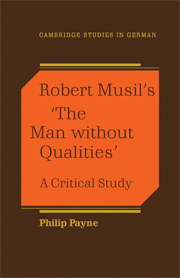Book contents
- Frontmatter
- Contents
- Preface
- A note on the translation of quotations and on references
- Part I Aspects of Musil's life and works
- Part II ‘The Man without Qualities’
- 4 Introduction
- 5 A critical approach to the structure
- 6 An investigation of two major themes
- 7 Moosbrugger – a study in applied subjectivity
- 8 Ulrich as ‘Man without Qualities’
- 9 Review of The Man without Qualities from the perspective of the narrator
- 10 Ulrich and Agathe
- Epilogue
- Notes
- Bibliography
- Index
5 - A critical approach to the structure
Published online by Cambridge University Press: 04 August 2010
- Frontmatter
- Contents
- Preface
- A note on the translation of quotations and on references
- Part I Aspects of Musil's life and works
- Part II ‘The Man without Qualities’
- 4 Introduction
- 5 A critical approach to the structure
- 6 An investigation of two major themes
- 7 Moosbrugger – a study in applied subjectivity
- 8 Ulrich as ‘Man without Qualities’
- 9 Review of The Man without Qualities from the perspective of the narrator
- 10 Ulrich and Agathe
- Epilogue
- Notes
- Bibliography
- Index
Summary
Introductory remarks
As indicated above, I do not believe that Musil structured the novel as a whole according to a master-plan – there were no ‘architect's drawings’ for The Man without Qualities which Musil carried through single-mindedly. It does, however, seem likely that Musil intended the completed novel to be roughly symmetrical. If it had been completed it might have looked as follows:
Part I – ‘Eine Art Einleitung’ (‘A Kind of Introduction’) (completed, with nineteen chapters)
Part II – ‘Seinesgleichen geschieht’ (‘The Same Kind of Things Happen Again’) (completed, with one hundred and four chapters)
Part III – ‘Ins Tausendjährige Reich’ (‘Die Verbrecher’) (‘Into the Millenium (The Criminals)’) (thirty-eight chapters completed, perhaps some sixty or so more envisaged)
Part IV – ‘Eine Art Ende’ (‘A Kind of Ending’) (possible title – no chapters written and only a few pages of notes extant, including Ulrich's so-called ‘final statement’. Musil may have intended Part IV to be roughly as long as Part I.)
Under these headings we can see a shape emerging: Part I provides an introduction to Ulrich and ‘Kakanien’ (this being Musil's ironical term for Austria-Hungary – the words ‘kaiserlich’ and ‘königlich’ referring to the Constitution of the Empire are here compressed into their initial letters, ‘k’ and ‘k’, to form a play on words, linking Austria-Hungary to the child's word for excrement), the world he inhabits.
- Type
- Chapter
- Information
- Robert Musil's 'The Man Without Qualities'A Critical Study, pp. 58 - 84Publisher: Cambridge University PressPrint publication year: 1988



